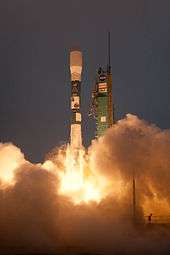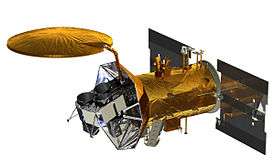SAC-D
|
Artist's impression of SAC-D | |||||||||||||||||||||
| Mission type |
Technology demonstration Earth observation | ||||||||||||||||||||
|---|---|---|---|---|---|---|---|---|---|---|---|---|---|---|---|---|---|---|---|---|---|
| Operator | CONAE / NASA | ||||||||||||||||||||
| COSPAR ID | 2011-024A | ||||||||||||||||||||
| SATCAT № | 37673 | ||||||||||||||||||||
| Website | conae.gov.ar | ||||||||||||||||||||
| Mission duration |
Planned: 5 years Final: 3 years, 11 months and 29 days | ||||||||||||||||||||
| Spacecraft properties | |||||||||||||||||||||
| Bus | Small Satellite Standard Platform[1] | ||||||||||||||||||||
| Manufacturer | INVAP[2] | ||||||||||||||||||||
| Launch mass | 1,350 kg (2,977 lb)[2] | ||||||||||||||||||||
| Dimensions | 2.7 × 5.0 m (8.9 × 16.4 ft)[2] | ||||||||||||||||||||
| Power | 1,362 watts[2] | ||||||||||||||||||||
| Start of mission | |||||||||||||||||||||
| Launch date | 10 June 2011, 14:20:13 UTC[3] | ||||||||||||||||||||
| Rocket | Delta II 7320-10C | ||||||||||||||||||||
| Launch site | Vandenberg SLC-2W | ||||||||||||||||||||
| Contractor | United Launch Alliance | ||||||||||||||||||||
| End of mission | |||||||||||||||||||||
| Last contact | 8 June 2015 | ||||||||||||||||||||
| Orbital parameters | |||||||||||||||||||||
| Reference system | Geocentric | ||||||||||||||||||||
| Regime | Low Earth | ||||||||||||||||||||
| Semi-major axis | 7,031.6 km (4,369.2 mi) | ||||||||||||||||||||
| Eccentricity | 0.000181 | ||||||||||||||||||||
| Perigee | 652.2 km (405.3 mi) | ||||||||||||||||||||
| Apogee | 654.7 km (406.8 mi) | ||||||||||||||||||||
| Inclination | 98.0 degrees | ||||||||||||||||||||
| Period | 97.8 minutes | ||||||||||||||||||||
| Epoch | 17 December 2015, 15:47:23 UTC[4] | ||||||||||||||||||||
| |||||||||||||||||||||
SAC-D (Spanish: Satélite de Aplicaciones Científicas-D, meaning Satellite for Scientific Applications-D), also known as Aquarius after its primary instrument, is an Argentine Earth science satellite built by INVAP and operated by CONAE.[1] SAC-D was launched from Vandenberg Air Force Base on 10 June 2011, with a planned mission life of five years.[1] Due to a power system failure, the mission was ended on 8 June 2015.[5]
Description
SAC-D was an international collaboration between the space agencies of Argentina and the United States, CONAE and NASA, with participation from Brazil (INPE), Canada (CSA), France (CNES) and Italy (ASI).[6] It carried five Earth observation instruments (NASA, CONAE, CSA, ASI), two space science instruments (CNES), a data collection instrument (CONAE), and a technology demonstration system (CONAE).[6][7][8]
The spacecraft's main instrument, Aquarius, was built by NASA's Jet Propulsion Laboratory and Goddard Space Flight Center.[6] It collected data from 25 August 2011 to 7 June 2015, exceeding its intended three year primary mission.[1][9] Aquarius' mission was to demonstrate that accurate measurements of salinity could be made from space, and was the first spaceborne instrument to use both passive radiometers and active radar in the L band.[1][6] By measuring ocean salinity, scientists are better able to understand the Earth's water cycle and ocean circulation.[6] Project scientists later derived a method of pulling soil moisture data from Aquarius' radiometer.[1]
Launch

NASA launched SAC-D from Vandenberg Air Force Base's Space Launch Complex 2W aboard a Delta II 7320-10C on 10 June 2011 at 14:20:13 UTC.[1][10] The launch was delayed from May 2010 because development of the spacecraft was taking longer than expected.[11]
Accomplishments
The Aquarius instrument's surface salinity measurements contributed to a better understanding of ocean dynamics and advancing climate and ocean models, both from season to season and year to year. The models still are improving El Niño prediction. Aquarius global salinity maps show how freshwater plumes coming from the mouth of large rivers and the precipitation and evaporation over the oceans affect the salinity structure of the ocean.
“The Aquarius sensor collected three years and nine months of valuable data. It was truly a pioneering effort to determine how accurately we could measure ocean salinity from space and for the first time study large and small-scale interactions of the global water cycle.” Aquarius principal investigator Gary Lagerloef of Earth & Space Research, Seattle.
Aquarius provided information into the natural exchange of freshwater between the ocean, atmosphere and sea ice, which influences ocean circulation, weather and climate.
Data from Aquarius showed how extreme floods affect the seas and how low-salinity river plumes affect hurricane intensity. Aquarius data was important to the Salinity Processes in the Upper Ocean Regional Study (SPURS), a year-long international field study of the oceanographic processes that sustain the maximum surface salinities in the central subtropical North Atlantic, and influence global ocean circulation.
The Aquarius instrument successfully achieved its science objectives and completed its primary three-year mission in November 2014.[12]
Failure of spacecraft
On 7 June 2015 at 12:53:17 UTC, telemetry indicated a failure of the spacecraft's Remote Terminal Unit (RTU), causing loss of onboard power regulation and attitude stabilization. While efforts were made to recover the spacecraft, the mission was declared over on 8 June.[9][12]
Instruments
| Abbreviation | Name | Operator | Purpose[7] |
|---|---|---|---|
| N/A | Aquarius | | Ocean salinity research |
| MWR | Microwave Radiometer | | Radiometry |
| NIRST | New Infrared Sensor Technology | | Infrared imagery, determination of sea temperatures |
| HSC | High Sensitivity Camera | | Imaging of aurorae, fires, and lights |
| DCS | Data Collection System | | Collection of data provided by platforms on Earth. Compatible with Argos system |
| TDP | Technological Demonstration Package | | Technology demonstration involving GPS navigation and inertial guidance |
| ROSA | Radio Occultation Sounder for Atmosphere | | Measurement of temperature and humidity in the atmosphere |
| ICARE-NG | Influence of Space Radiation on Advanced Components-New Generation | | Part of CARMEN-1 mission; study of cosmic radiation and its effects on electronics |
| SODAD | Orbital System for an Active Detection of Debris | | Part of CARMEN-1 mission; study of particles and debris in space |
See also
References
- 1 2 3 4 5 6 7 "SAC-D (Satélite de Aplicaciones Científicas-D)/Aquarius Mission". eoPortal. European Space Agency. Retrieved 18 December 2015.
- 1 2 3 4 "Press Kit: Aquarius/SAC-D Launch" (PDF). NASA. June 2011. Retrieved 18 December 2015.
- ↑ Graham, William (10 June 2011). "ULA Delta II launches with the SAC-D spacecraft". NASA Spaceflight. Retrieved 18 December 2015.
- ↑ "Aquarius - Orbit". Heavens Above. 17 December 2015. Retrieved 18 December 2015.
- ↑ Clark, Stephen (17 June 2015). "International ocean research observatory fails in orbit". Spaceflight Now. Retrieved 18 June 2015.
- 1 2 3 4 5 Graham, William; Bergin, Chris (17 June 2015). "Farewell Aquarius as SAC-D spacecraft concludes its mission". NASA Spaceflight. Retrieved 18 December 2015.
- 1 2 "Aquarius/SAC-D onboard instruments". CONAE. Retrieved 18 December 2015.
- ↑ Miklus, Nicole; deCharon, Annette (2010). "Aquarius/SAC-D: Sea Surface Salinity from Space" (PDF). NASA/University of Maine. Retrieved 18 December 2015.
- 1 2 Lagerloef, Gary; Torrusio, Sandra (18 June 2015). "PI Announcement to Science Team and Broader Science Community". University of Maine. Retrieved 18 December 2015.
- ↑ Buis, Alan; Cole, Steve (10 June 2011). "NASA's 'Age of Aquarius' Dawns With California Launch". NASA. Retrieved 10 June 2011.
- ↑ Clark, Stephen (26 December 2009). "Ocean-watching satellite facing delays in Argentina". Spaceflight Now. Retrieved 6 January 2010.
- 1 2 Brown, Dwayne; Gran, Rani; Buis, Alan (17 June 2015). "International Spacecraft Carrying NASA's Aquarius Instrument Ends Operations". NASA. Retrieved 18 December 2015.
External links
| Wikimedia Commons has media related to SAC-D. |
- SAC-D website by CONAE
- SAC-D website by INVAP
- Aquarius website by NASA
- Aquarius website by the University of Maine
